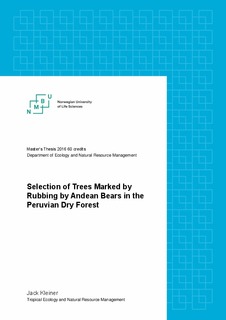| dc.contributor.advisor | Swenson, Jon | |
| dc.contributor.advisor | Steyaert, Sam | |
| dc.contributor.author | Kleiner, Jack | |
| dc.coverage.spatial | Peru | nb_NO |
| dc.date.accessioned | 2016-08-31T11:03:14Z | |
| dc.date.available | 2016-08-31T11:03:14Z | |
| dc.date.issued | 2016-08-31 | |
| dc.identifier.uri | http://hdl.handle.net/11250/2403104 | |
| dc.description.abstract | The Andean bear (Tremarctus ornatus) is one of the least known species of Ursidae. One area about which very little is known is the bear’s marking behavior. This is a key aspect of bear ecology and marks can give information on the behavior and relative abundance of the species in an area. Mammalian selection of marking sites is associated with location, often in areas frequently used by conspecifics, and the physical characteristics of the tree or substrate used for marking. In this study I tested the hypothesis that Andean bears in the Peruvian dry forest leave more rub marks on trees close to water and on certain species based on the size and characteristics of the tree. Analysis of 117 mark locations, 94 rub trees and 243 available trees within a 5-m radius of rub trees, hereafter called unmarked trees showed that the bears preferred to rub trees with a smaller height and closer to water holes. Water is rare in the dry forest and waterholes act as a central point for bear activity. The highest selection ratio for rub trees was found for chilco (Baccharis sp), chaquiroz (Pithecellobium excellsum), vichayo (Beautempsia avicenniifolia), and vichayo falso (Capparicordis crotonoides). These species may have been chosen because of the resin and sap properties of the bark and the trees’ aroma, which could help the persistence and detection of bear signal by conspecifics. This study presents the first insight into how bears of the Peruvian dry forest rub trees for communication and could assist in future study and conservation of this species. | nb_NO |
| dc.language.iso | eng | nb_NO |
| dc.publisher | Norwegian University of Life Sciences, Ås | |
| dc.rights | Navngivelse-Ikkekommersiell 3.0 Norge | * |
| dc.rights.uri | http://creativecommons.org/licenses/by-nc/3.0/no/ | * |
| dc.subject | Andean bear | nb_NO |
| dc.subject | Tremarctos ornatus | nb_NO |
| dc.subject | Peruvian Dry forest | nb_NO |
| dc.subject | Marking behavior | nb_NO |
| dc.title | Selection of trees marked by rubbing by Andean bears in the Peruvian dry forest | nb_NO |
| dc.type | Master thesis | nb_NO |
| dc.subject.nsi | VDP::Mathematics and natural science: 400::Zoology and botany: 480::Ecology: 488 | nb_NO |
| dc.source.pagenumber | 36 | nb_NO |
| dc.description.localcode | M-ECOL | nb_NO |

